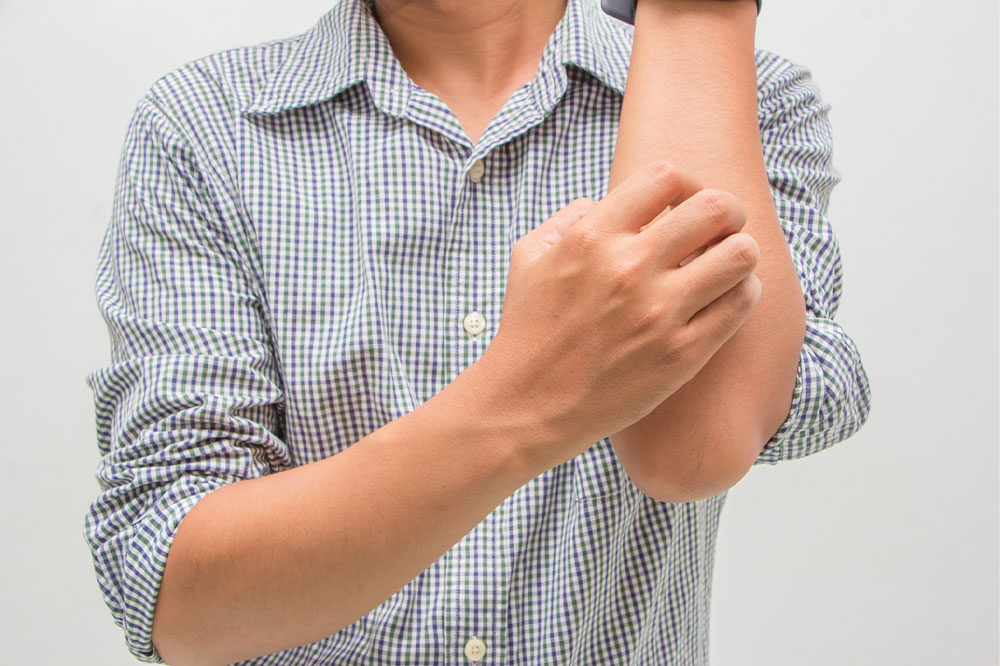
A brief overview of plaque psoriasis
Affecting more than eight million people in the country, plaque psoriasis is one of the most common forms of psoriasis. It results in dry and itchy skin patches, which are also known as plaques. They generally appear around the elbows, knees, lower back, and scalp. Plaque psoriasis is an auto-immune disease. The direct causes of the condition are still not known. But certain triggers linked to the disease have been identified.
Out of every three persons with psoriasis, one has reported having a family history of, or a family member with psoriasis. When both parents have psoriasis, the child has a 50 percent chance of developing psoriasis as well, indicating that psoriasis is passed genetically.
Skin injuries like sunburns can sometimes trigger psoriasis in people. Extremely dry or cold weather conditions, and high levels of stress can also expose people to psoriasis.
What are the common symptoms?
Common symptoms of plaque psoriasis include:
- Rashes or patches of red, inflamed skin
- Itching, burning, or soreness
- Discoloration or pitting in fingernails and/or toenails
- Scaly plaques on the scalp
- Bleeding (around dry, cracked, and irritated skin)
Foods to eat and avoid
When suffering from plaque psoriasis, it is best to eat anti-inflammatory foods like tempeh, fish, fruits, vegetables, legumes, nuts, seeds, whole grains, low-fat dairy, and olive oil. These foods are known to alleviate inflammation and soothe symptoms of psoriasis.
Even though every individual reacts differently to the food they consume, there are certain inflammatory foods that one should stay away from. These include high-calorie foods; foods with refined carbohydrates or saturated fats; sugary foods; and gluten-rich foods. Speak with a nutritionist before eliminating or adding any food from your daily meals.
How is plaque psoriasis treated
Depending on the severity, different treatment methods may be recommended. These may include either one or a combination of the following:
Topical ointments
For mild psoriasis, doctors will try a prescription cream first, which is applied directly to the affected area. These ointments generally include Vitamin A, Vitamin D, salicylic acid, and/or coal tar. Other soothing agents like aloe vera or jojoba may also be included.
Light therapy
For wider spread plaques, doctors may suggest using ultraviolet light as a treatment. This may be done at the doctor’s office, or at home. It may also help if a person gets some exposure to the sun. However, one should remember to always wear sunscreen on unaffected areas to reduce the risk of skin cancer.
Systemic treatment
For more severe cases, doctors may prescribe treatments that work throughout the body to calm your immune system and help the skin cells grow back slowly. These treatments may be accompanied by side effects like aggressive thoughts, liver failure, or increased risk of skin cancer.
Biologics
This is a type of systemic treatment. Biologics target a specific type of immune cell that is known to cause psoriasis. They also prevent certain proteins from causing inflammation. Side effects can include lower immunity to future infections.
Natural remedies
It may be beneficial for some people with plaque psoriasis to supplement their clinical treatment with home remedies. Some of these are:
Salt baths
Warm salt baths with Epsom salt or olive oil can soothe the skin and calm inflammation temporarily.
Turmeric
Turmeric’s anti-inflammatory properties may help soothe the skin and provide relief from psoriasis. It can be applied as a paste or gel on the lesions for reducing itching and scaly skin.
Aloe vera
Topical aloe vera extract can be applied to the skin to help with redness, itching, and scaling.
Omega-3 fatty acids
Omega-3 fatty acids have anti-inflammatory properties. Eating Omega-rich foods such as walnuts, hazelnuts, pecans, soy, and some types of fish can help combat inflammation and scaling.




